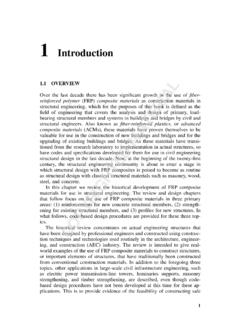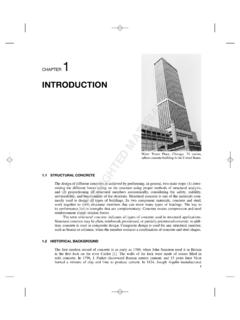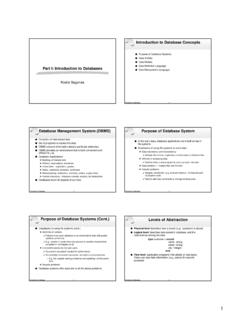Transcription of Engineering Aspects of Electromagnetic Shielding
1 Engineering Aspects of Electromagnetic ShieldingDr. Sergiu RaduPrincipal Engineer, EMC Design Sun Microsystems, introduction : Electric, Magnetic and Electromagnetic Shielding Basics approaches to Shielding : field theory (Kaden) and circuit theory (Schelkunoff) Limits of the theoretical approaches: numerical simulations Practical Aspects of Shielding , typical requirements, grounding scheme Shield material: metal, plastic, typical coatings Shield construction: rivets, joints, seams, apertures Shielding and thermal issues: holes, perf patterns, honeycomb Shield integrity and gaskets Internal compartmentalization of a chassis, resonances Practical Aspects of source - aperture coupling Shielding for radiated emissions, radiated immunity and ESD - reciprocity Aspects and limits Evaluation of Shielding effectiveness3 introduction In order to have an EMI problem we must have: One or multiple noise sources (typically the CPUs, ASICs, DC/DC, other ICs, etc.)
2 One or multiple coupling paths (capacitive, inductive, galvanic, field coupling) One or multiple antennas (cables, apertures, holes, seams, etc.) The best way is to control EMI at the source whenever possible and to add containment measures at every other level (coupling paths, antennas). The noise source, the coupling path and the antennas are all frequency dependent, and this increases very much the complexity of the problem. All the EMI problems deal with parasitics. The characterization of all the EMI Aspects is never part of the data sheet, making all modeling attempts very Mechanism 5 Shielding EeEi [dB] HeHi [dB] PePi [dB]Ee=Electricfield exterior Ei=Electricfield interior He=Magneticfield exterior Hi=Magneticfield interior Pe=Power exterior Pi=Power interior For external noise source (immunity):6 Shielding Effectiveness7 Near Field vs.
3 Far Field for Point Sources ZW m=dE dH = j r2 2vrj vr2 1r3 2v2r ZW e=dE dH =1 j v2r 1vr2 1j r3j vr 1r2 ZW m=dE dH j r ZW e=dE dH 1j rZW=dE dH =1 v=1 1 = 0 0=120 =377 Small electric dipole Small electric dipole Small electric dipole Small current loopFar Field (Radiation Zone, Fraunhoffer Zone): Near Field (Reactive Field or Fresnel Zone) 8 Near Field vs. Far Field Impedance for Point Sources9 Impedance Method (TL, Schelkunoff) = j j = R j L G j C Z = j j Zc= R j LG j C(propagation constant)(medium intrinsic impedance)10 Impedance Method Reflected & Transmitted Waves Z1= 0 0=120 =377[ ] openspaceimpedance Z2= j j [ ] shieldintrinsicimpedance R=20log10 Z2 Z1 24Z2Z1 [dB] R=Reflectionlosses 11 Absorption Losses & Skin EffectA= d [dB] AbsorptionLosses B=20log 1 e 2d [dB] Correctionforthinshields R B[dB] ShieldingEffectiveness = 2 =1 f Where.
4 = skin depth (mm) = angular (radian) frequency = material permeability (4 x 10-7 H/m = material conductivity ( x 107 mho/m for Cu)f = frequency (hertz)d = thickness of the shield (mm)12 Magnetic Behavior of Materials13 Impedance Method for Multilayer Shields14 Circuit Method H. KadenNeeds continuity of the shield for the circulation of the Eddy currents (Foucault currents)15 Mathematical Approach for Circuit Method E= 2 E H= 2 H 2=j j = j =1 j [m 1] = 2 [m] =j =j 0=j v=j2 Consider a homogeneous, isotropic, non-polarized medium without electric charges, and from Maxwell's equations obtain the Helmholtz's equations (propagation equations): Propagation constant for harmonic field: In metal: In dielectric: Solve the Helmholtz's equation in each of the three regions: exterior space (air), interior space (air), and in the wall of the shield (metal).)
5 Use boundary conditions, continuity and conservation of the tangent component of the field at each of the shield's surfaces to find the integration constants and obtain the unique solution, and the (source of the field placed at infinity) Use the separation of variables method to solve Helmholtz's equation. This is possibleonly for 11 geometries with orthogonal coordinates (plan-parallel, spheric, cylindrical, elliptic, parabolic, toroidal, etc.)16 Circuit Method Applied for the Plan-Parallel [dB]=10log[12 cosh2d cos2d 0x0 sinh2d sin2d 0x0 2 cosh2d cos2d ]17 Circuit Method Applied for the Spherical [12 cosh2d cos2d 5A2 2B2 2AB 12 cosh2d cos2d ..][.. A sinh2d 2sin2d B sinh2d sin2d ]A= 3 oroB= oro3 = 2 18 Example of Field Behavior (Spherical Shield)LF Magnetic Material (no tangential field)(No Shielding effect for non-magnetic)HF Magnetic or Non-Magnetic Material(no radial field component on the exterior)19 Circuit Method and Multilayer Shields Double shield from materials with the same magnetic behavior (Cu + Al) is worse than a single shield with equivalent thickness.
6 If the materials have different magnetic behavior thedouble shield is with 6dB better (for example Cu+ Ni). In general, equal thickness is best. Triple shield works best with materials of equal thickness and alternating magnetic behavior, the most conductive toward the noise source. There is a difference between laminated shields and double shields (air separation).20 Limits of the Analytical Methods Analytical methods: impedance method (Schelkunoff) - infinite sheet of metal separation of variables (Kaden) theoretically possible for 11 geometries) Physical insight and precision - perfect as a benchmark for the evaluation of the numerical methods.
7 Numerical simulation (FDTD, FEM, MoM, etc.) - can t be used for real life situations, no physical insight, difficult to characterize the noise source, internal reflections, large size of the file, etc. Very good for simple cases to analyze a trend or principle. Experimental methods - the only real validation of the analytical or numerical models. In the end, all these are about material and thickness of the shield, and to a little extent about the geometry (circuit method).21 Shielding and Reciprocity Reciprocity principle is applicable only to passive and linear circuits (a CPU, ASIC, IC is active and non-linear). Reciprocity requires us to consider only those parts of the system that meet the criteria of passiveness and linearity.
8 In this sense, within an electronic system, the properties of radiators/sensors can often be assumed to be reciprocal, just as is the case with antennas. In Shielding practice, we can find non-linear effects, like the "rusty bolt" effect, which results in nonlinear and non-reversible conductivity (diode). Another typical example from Shielding practice, is a multilayer shield, with one of the layers having nonlinear magnetic permeability. If the shield is linear, the reciprocity principle requires that Z21=Z12. The same requirements for passive, linear, circuits hold. As long as the shield is a passive network and its material exhibits linear electric and magnetic properties, the reciprocity theorem holds, and the same Shielding parameters are true for emissions and susceptibility.
9 However, this is true only at the levels of the shield transfer function, but not at the system level Shielding effectiveness. For example, a dominant radiator in the system (emissions case) was not necessarily the dominant victim in the same system (immunity case). For instance, one of the reasons that the radiator is dominant for emissions may be a high level of signal within it which, on the other hand, makes this particular part of the system more immune to EMI. Typically, the Tx (transmitting) output signal is 20dB stronger than Rx (receiving) input of Shielding Materials (MIL285, IEEE 299, ASTM D4935) ASTM D493530 MHz - of Shielding Materials Dual TEM Cell*ASTM D4935 Coaxial TEM * Two coupled stirred mode reverberation chambers as a HF alternative (Qinetiq)24 IEEE 299 Measuring SE of EnclosuresSchematic diagram of the test configuration for magnetic testsshowing dimensions of transmit (TX) and receive (RX) antennasMeasurement setup for frequencies >1 GHz25 Experimental Setup26 Chassis ResonancesThe resonance frequencies in a rectangular box are given by.
10 L = lengthH = heightW = widthwhere the case i=j=k=0 is forbiddenfijk=c2 r r i L 2 j H 2 k W 2fijk=150 iL 2 jH 2 kW 2( for vacuum )27 Rectangular Box - Lowest Resonance At higher frequency (for example >1 GHz), the enclosure supports a very large number of modes. Lowest modes: 223, 336, 404, 446, 559, 669, 673, .. MHz. An empty box has very high Q, very sharp resonances. The energy stored is proportional to volume, and losses are proportional with the surface Distributions at Resonant FrequenciesHzXZTMy201 - Ey(x,z) (rear)EyXZTMy201 - Hx(x,z) (rear)HxXZHxXZHzXZ Empty box: Q=5000, Fully loaded, densely populated box: Q=5-25 (practical implications) Use extensively internal compartmentalization (limit excitations, lower Q, upper f)29 Significance of +()k1+() i1+() 1j1+()k1+() 1k1+()i1+() 1j1+()i1+() 20000 Fij,k,()F0j,k,(),Fi0,k,(),Fij,0,(),Y-amp litudedenotessignificanceof modeMHz Most energy stored in the lower modes Can we limit the upper frequency of interest?











